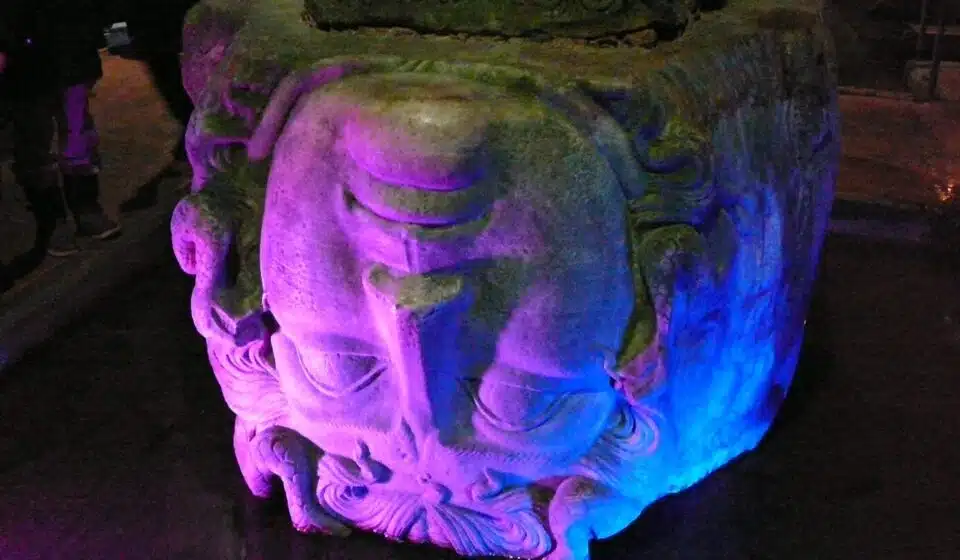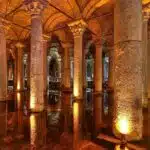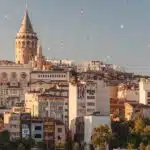
Intricate Details and Hidden Gems of the Basilica Cistern
At first glance, the Basilica Cistern appears as a symmetrical forest of columns reflected in still water. But beyond its dramatic ambiance lies a world of hidden chambers, mysterious symbols, and forgotten artifacts waiting to be uncovered. In this article, we dive deeper into the cistern’s secrets, symbols, and subtle beauty — the details that most visitors miss but historians and explorers love.
Secret Chambers and Passages
While the main hall of the Basilica Cistern is open to the public, many believe that hidden tunnels and sealed-off chambers still lie beneath Istanbul. Some researchers and restoration workers have reportedly discovered narrow crawl spaces leading into side passages.
These mysterious extensions, though not officially accessible, are believed to have once served as maintenance routes or emergency exits. There are even whispers that one passage may have led directly to the Great Palace of Constantinople, offering a secure waterway for the imperial family.
⛔ Note: These areas remain off-limits to the public, but their existence adds an exciting layer of mystery to the site.
Decorative Elements and Inscriptions
Beyond its structural brilliance, the cistern is full of decorative flourishes that reflect both Byzantine artistry and reused pagan symbolism.
- Several columns feature peacock eye motifs, leaf carvings, and fluting—each carrying potential symbolic meaning.
- One unique column, known as the “Weeping Column”, is adorned with teardrop shapes — believed to honor fallen workers who died during the cistern’s construction.
- Faint Greek and Latin inscriptions can still be seen on certain stones, marking their original source or the name of the artisan who carved them.
These subtle details reveal the cultural layering of the structure — where Roman, Greek, and Christian influences merge under one shadowy ceiling.
Ancient Artifacts and Treasures Discovered in the Cistern
Over the years, excavations have unearthed tools, pottery shards, coins, and even Byzantine seals in the cistern’s sediment.
Some of the most notable discoveries include:
- Byzantine copper coins dating back to the 6th and 7th centuries
- Roman amphora fragments (ceramic storage jars)
- Marble fragments from older temples repurposed during construction
- Occasional findings of bones, raising speculation about possible burials or sacrifices (though unconfirmed)
While none of these artifacts are on display inside the cistern, many are housed in the Istanbul Archaeological Museum, offering visitors a chance to explore the tangible history connected to the site.
Watermarks and Other Natural Phenomena
One fascinating yet often overlooked detail is the presence of watermarks on the cistern’s columns and walls. These subtle rings indicate historical water levels, giving clues about how much water was stored during different eras — especially during droughts or wartime.
Other natural phenomena include:
- Dripping patterns caused by condensation, which resemble veins or vines on the columns
- The reflection of light on water forming mirror illusions
- A distinct cool microclimate, maintained naturally underground
These natural effects not only enhance the mystical atmosphere but also provide silent testimony to the cistern’s evolving usage through centuries.
Meaning Behind the Various Symbols and Motifs
Symbols are everywhere in the Basilica Cistern — if you know where to look.
- Medusa heads are the most famous, likely used to ward off evil or repurpose pagan power into Christian settings.
- Peacock eye designs, found on some columns, were ancient symbols of eternal life and resurrection.
- Teardrop motifs on the Weeping Column represent grief, sacrifice, and labor — a subtle nod to the lives lost building this underground marvel.
- Occasional crosses and Greek initials suggest the Christianization of earlier pagan stonework.
Together, these motifs form a visual language of protection, memory, and power, making the cistern not just a utility structure, but a spiritual and symbolic space.
Conclusion
The Basilica Cistern isn’t just a water reservoir — it’s a hidden world, layered with symbols, stories, and secrets. Every column holds a mystery; every shadow reveals a whisper from the past. For those who look beyond the surface, the cistern offers not just beauty, but depth — a journey into the forgotten corners of Istanbul’s soul.
So next time you descend into its depths, pause… look closer… and you just might find something no one else noticed.

